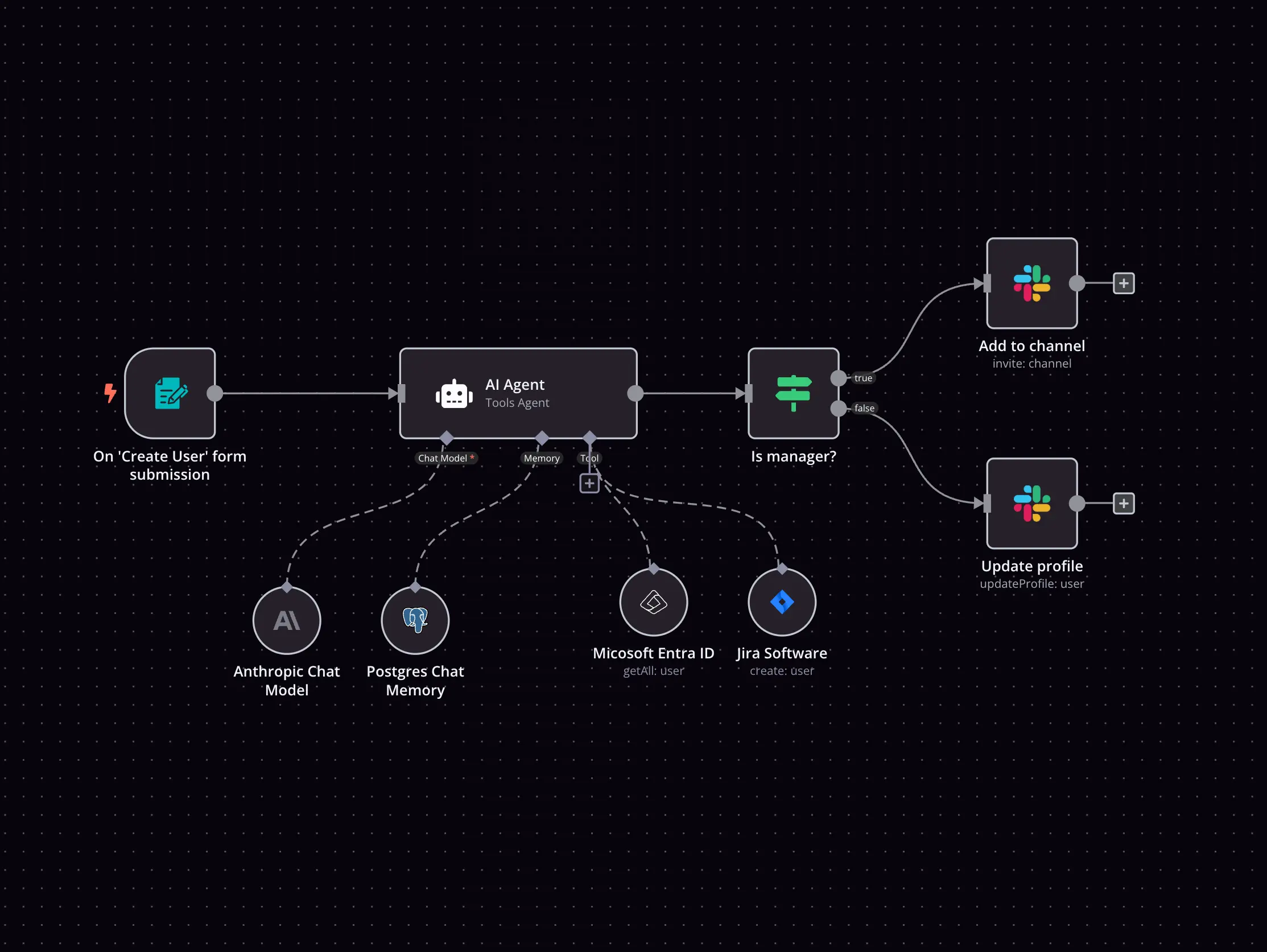Flotiq and Mailersend integration
Save yourself the work of writing custom integrations for Flotiq and Mailersend and use n8n instead. Build adaptable and scalable Development, workflows that work with your technology stack. All within a building experience you will love.


How to connect Flotiq and Mailersend
Create a new workflow and add the first step
In n8n, click the "Add workflow" button in the Workflows tab to create a new workflow. Add the starting point – a trigger on when your workflow should run: an app event, a schedule, a webhook call, another workflow, an AI chat, or a manual trigger. Sometimes, the HTTP Request node might already serve as your starting point.
Build your own Flotiq and Mailersend integration
Create custom Flotiq and Mailersend workflows by choosing triggers and actions. Nodes come with global operations and settings, as well as app-specific parameters that can be configured. You can also use the HTTP Request node to query data from any app or service with a REST API.
Supported API Endpoints for Flotiq
List content types
Retrieves a list of all content types available.
Create content type
Creates a new content type.
Update content type
Updates an existing content type.
Get single content type
Retrieves details of a specific content type.
Delete content type
Deletes a specific content type.
Create content type
Create a new content type definition.
Get content type
Retrieve a specific content type definition.
Update content type
Update an existing content type definition.
Delete content type
Delete an existing content type definition.
Create content type
Creates a new content type for the application.
Update content type
Updates an existing content type in the application.
List content types
Retrieves a list of all content types available in the application.
Get single content type
Retrieves a specific content type by its ID.
Delete content type
Deletes a specified content type from the application.
Create content type
Creates a new content type definition via API.
Update content type
Updates an existing content type definition.
List content types
Retrieves a list of content type definitions.
Get single content type
Retrieves a single content type definition by ID.
Delete content type
Deletes a specific content type definition by ID.
List content objects
Retrieves a list of all content objects.
Create content object
Creates a new content object.
Update content object
Updates an existing content object.
Get single content object
Retrieves details of a specific content object.
Delete content objects
Deletes a specific content object.
Create content object
Creates a new content object in the application.
Update content object
Updates an existing content object in the application.
List content objects
Retrieves a list of all content objects available in the application.
Get single content object
Retrieves a specific content object by its ID.
Delete content object
Deletes a specified content object from the application.
List deleted content objects
Retrieves a list of all deleted content objects.
Create content object
Creates a new content object based on a content type.
Update content object
Updates an existing content object.
List content objects
Retrieves a list of content objects.
Get single content object
Retrieves a single content object by ID.
Delete content object
Deletes a specific content object by ID.
Retrieve content object
Retrieve the schema of a specific Content Object by sending a GET request.
Delete content object
Delete a specific Content Object identified by its ID.
Retrieve GraphQL schema
Retrieve the GraphQL schema that describes your data.
Execute GraphQL queries
Execute GraphQL queries to retrieve specific data.
Get blogposts
Retrieve details of blogposts content type.
Create content type
Create a new Content Type Definition in the system.
Update content type
Updates the definition of the specified content type using a PUT request.
Update blogposts
Updates the schema definition for blog posts.
To set up Flotiq integration, add the HTTP Request node to your workflow canvas and authenticate it using a generic authentication method. The HTTP Request node makes custom API calls to Flotiq to query the data you need using the API endpoint URLs you provide.
See the example hereThese API endpoints were generated using n8n
n8n AI workflow transforms web scraping into an intelligent, AI-powered knowledge extraction system that uses vector embeddings to semantically analyze, chunk, store, and retrieve the most relevant API documentation from web pages. Remember to check the Flotiq official documentation to get a full list of all API endpoints and verify the scraped ones!
Supported API Endpoints for Mailersend
Send email
This endpoint allows you to send an asynchronous email.
Send email
This endpoint allows you to send an email message.
Send bulk emails
This endpoint allows you to send multiple asynchronous emails.
Get bulk email status
Check the bulk email status using the bulk_email_id.
Send bulk email
Send multiple emails in a single request.
Get activity
Retrieve the activity logs of sent emails.
List activities
Get a list of email activities using the API.
Get analytics
Fetch analytics data for your sent emails.
List domains
Get a list of validated domains for your account.
List sender identities
Retrieve a list of sender identities associated with your account.
Manage inbound routing
Set up and manage inbound routing for received emails.
List inbound routes
Retrieve information about multiple inbound routes.
Get inbound route
Retrieve a single inbound route using the inbound_id.
Add inbound route
Add a new inbound route to a domain.
Update inbound route
Update the information of an existing inbound route.
Delete inbound route
Use this request to delete an inbound route.
List messages
Retrieve a list of sent messages.
Schedule a message
Create and schedule messages to be sent at a later time.
List recipients
Get a list of recipients for the emails you've sent.
List recipients
Retrieve the email addresses of recipients using this GET request.
Get a single recipient
Retrieve the information of a single recipient and its domain.
Delete recipient
Delete the information of a single recipient and its domain using this DELETE request.
Create recipient
Add a recipient to the block list using a specified domain ID and recipient email.
Add to block list by pattern
Add a recipient to the block list using patterns that match email addresses.
Add to hard bounces
Add a recipient to hard bounces under a specified domain ID.
Add to spam complaints
Add a recipient to spam complaints using their email address and domain ID.
Add to unsubscribes
Add a recipient to unsubscribes with their domain ID and email.
Create a template
Generate and save email templates.
Manage webhooks
Set up and configure webhooks for your application.
Send SMS
Utilize this endpoint to send SMS messages.
List phone numbers
Retrieve a list of phone numbers used for sending SMS.
List SMS messages
Get a record of SMS messages sent from your account.
List users
Retrieve a list of users in your MailerSend account.
Create rejected-shortened-url
There was an error with the shortened URL used.
Create destination-rejected-message
The destination carrier has rejected the message but provided no specific reason.
Create destination-rejected-message-size-invalid
Carrier has rejected for message length is invalid or too long.
Create destination-rejected-malformed
Carrier is rejecting the message malformed.
Create destination-rejected-handset
The handset has rejected the message.
Create destination-spam-detected
The Carrier is reporting this message as blocked for SPAM.
Create destination-rejected-due-to-user-opt-out
User has opted out of receiving messages from a particular sender.
Create volumetric-violation
The carrier rejected the message due to a volumetric violation.
Create tfn-not-verified
The message was blocked due to the toll free number not being verified.
Create temporary-app-error
An application within the MailerSend service is experiencing a temporary error.
Create destination-carrier-queue-full
Carrier Service Unavailable.
Create destination-app-error
The carrier is reporting a general error associated with their application processing the message.
Create message-send-failed
The destination carrier has reported a general service failure with sending the message.
List identities
Retrieve information about sender identities with this GET request.
Get identity
Retrieve a single sender identity by its identity ID.
Get identity by email
Retrieve a single sender identity by email.
Add identity
Add a new sender identity to send emails without verification.
Update sender identity
Update the information of an existing sender identity.
Update sender identity by email
Update the information of an existing sender identity by email.
Delete identity
If you want to delete a sender identity, use this DELETE request.
Delete identity by email
If you want to delete a sender identity by email, use this DELETE request.
Update inbound route
Update an existing inbound routing configuration.
Get recipients
Retrieve the recipients in a blocklist of an account or domain by passing the blocklist ID with this GET request.
List hard bounces
Retrieve the hard bounced recipients of an account or domain.
List spam complaints
Retrieve the recipients who have made a spam complaint for an account or domain.
List unsubscribes
Retrieve the unsubscribed recipients from an account or domain.
Retrieve on hold recipients
Retrieve on hold recipients for an account or domain by passing its ID.
Add a recipient to a blocklist
Add a recipient to a blocklist with this request.
Add hard bounce
Add a hard bounce for one or more recipients.
Add spam complaint
Add a spam complaint for one or more recipients.
Set unsubscribed
Set one or more recipients as unsubscribed.
Delete blocklist entries
Delete one or more blocklist entries with this request.
Delete hard bounces
Delete one or more hard bounces from recipients by passing the hard bounces IDs.
Delete spam complaints
Delete one or more spam complaints from recipients by providing the spam complaint IDs.
Delete unsubscribes
Delete one or more unsubscribes from recipients by providing the unsubscribe IDs.
To set up Mailersend integration, add the HTTP Request node to your workflow canvas and authenticate it using a generic authentication method. The HTTP Request node makes custom API calls to Mailersend to query the data you need using the API endpoint URLs you provide.
See the example hereThese API endpoints were generated using n8n
n8n AI workflow transforms web scraping into an intelligent, AI-powered knowledge extraction system that uses vector embeddings to semantically analyze, chunk, store, and retrieve the most relevant API documentation from web pages. Remember to check the Mailersend official documentation to get a full list of all API endpoints and verify the scraped ones!
Flotiq and Mailersend integration details
FAQ
Can Flotiq connect with Mailersend?
Can I use Flotiq’s API with n8n?
Can I use Mailersend’s API with n8n?
Is n8n secure for integrating Flotiq and Mailersend?
How to get started with Flotiq and Mailersend integration in n8n.io?
Looking to integrate Flotiq and Mailersend in your company?
The world's most popular workflow automation platform for technical teams including
Why use n8n to integrate Flotiq with Mailersend
Build complex workflows, really fast


